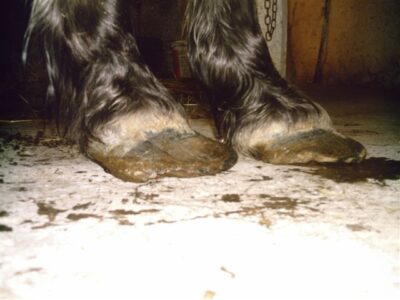Under-run heels are identified by their appearance as being extremely low and acutely sloping forward, to the point where they have no weight bearing ability. (Pic 1).
The low-heeled hoof is usually accompanied by a long and concaved hoof capsule at the toe due to the tubules bending under the pressure of their excessive length.
A percentage of under-run heels is caused by bad conformation i.e. long sloping pasterns which encourage pressure at the heels, causing them to collapse and roll under. Others are related to the lack of proper hoof maintenance, such as not trimming these hooves before they grow too long or then not trimming them to the required correct hoof/pastern angle, which reduces the pressure at the heels.
The long-toe low-heeled horse becomes unsteady in its gait or stumbles and will tend to over-reach with the hinds coming through and hitting the heels of the front hooves, because the long toes slow down the movement of the front hooves. The initial treatment should be to shorten the toes as much as possible and re-trim every three weeks for about three successive periods after which time the heels may have started to grow down.
The old method was to use wedges under the heels of the shoe to gain the correct hoof-pastern angle, however studies have shown that this method only crushes the already deficient heels further. So if corrective trimming has not achieved the required heel growth, the next option is to fit graduated shoes which are thicker at the heels and reducing to the toe; these will improve the horse’s mobility but are only a quick fix, as they still put too much pressure on the weak heel area and will inhibit their recovery.

